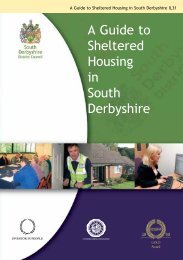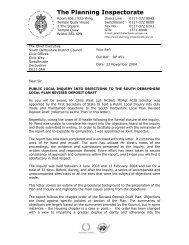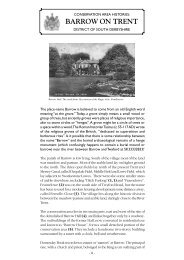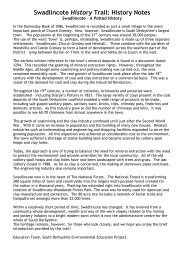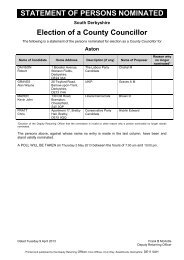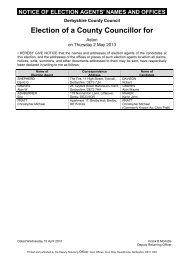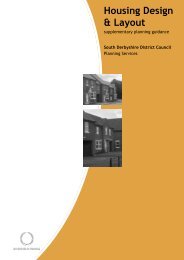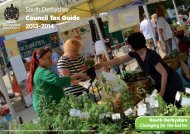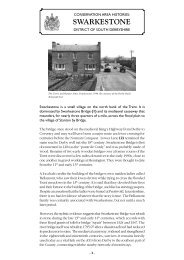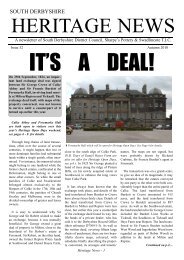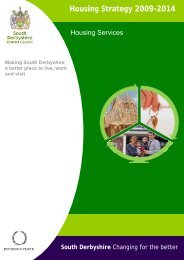Heritage News 19 - South Derbyshire District Council
Heritage News 19 - South Derbyshire District Council
Heritage News 19 - South Derbyshire District Council
You also want an ePaper? Increase the reach of your titles
YUMPU automatically turns print PDFs into web optimized ePapers that Google loves.
UNUSUAL HISTORIC DIARY<br />
PUBLISHED<br />
Victorian life in a <strong>South</strong> <strong>Derbyshire</strong> village seen through the eyes<br />
of a gentleman farmer, poet, natural and local historian is revealed<br />
in a new book published by the Melbourne Historical Research<br />
Group, in conjunction with <strong>Derbyshire</strong> County <strong>Council</strong> and <strong>South</strong><br />
<strong>Derbyshire</strong> <strong>District</strong> <strong>Council</strong>. Priced at £10.99, the book is good<br />
value with more than 240 pages including a sixteen-page colour<br />
section.<br />
John Joseph Briggs from King’s Newton in the parish of Melbourne<br />
kept a diary from 1845 to 1875 covering all aspects of life from<br />
national events to ‘everyday tales of village folk’. A few<br />
retrospective entries record events back to 1820. Now his<br />
thoughtful and unusual memoir spanning 55 years has been<br />
transcribed from the original manuscript into a glossy paperback,<br />
which was launched at Melbourne on Friday 22 April.<br />
Nominally a farmer, Briggs himself confessed that “To employment<br />
of an agricultural nature I had from infancy a great aversion”.<br />
Moreover, Briggs never enjoyed good health and was the only<br />
one of his parents eight children to achieve the age of 25. So after<br />
his father ceased to be active on the farm, he managed the office<br />
side of the business and left the heavy work to employees. The<br />
farm was a prosperous one on the Melbourne Estate, and was<br />
profitable enough to support Briggs while he did much as he liked.<br />
He wrote extensive notes on natural and local history, composed<br />
poetry and published three histories of Melbourne in 1839, 1852<br />
and 1870.<br />
As an amateur historian, it’s not surprising that Briggs wrote his<br />
diary with posterity in mind. He probably never dreamt that it would<br />
ever be published, but he certainly wanted future generations to<br />
read it.<br />
“Many of the notes I am fully aware may seem uninteresting and<br />
unworthy of record and yet I cannot but imagine that even the<br />
most trivial in distant years must be found useful - for oftentimes a<br />
small well authenticated fact tends most materially to forward a<br />
great end. Improvements are in progress and we like to see the<br />
state of objects before such were effected. Times & manners change<br />
and man loves to contemplate how men lived & acted before him.<br />
We live in a changing age and I conceive that half a century hence<br />
we shall view the present time with as much amusement as we<br />
now look back upon that which is past.”<br />
The content of the diary is wide-ranging. Briggs describes events<br />
of national significance like the<br />
Crimean War down to the latest<br />
fashions of home life, such as the<br />
introduction of Christmas trees or<br />
the new trend for growing a<br />
beard. One of the diary entries<br />
describes how plans for a new<br />
railway line linking Rugby and<br />
Manchester were opposed at<br />
Swarkestone by Sir John Harpur<br />
Crewe of Calke who hired fifty<br />
people to prevent surveyors<br />
entering his land. Briggs<br />
•J.J. Briggs as a young man.<br />
By courtesy of Mr G.R. Heath.<br />
describes how “The company<br />
procured about eighty others<br />
from Melbourne and<br />
<strong>Heritage</strong> <strong>News</strong> - 4<br />
elsewhere…when Sir John’s men saw the opposite party were not<br />
to be lightly frustrated they quietly and very prudently withdrew.”<br />
The diary also reveals that the Victorians experienced some of the<br />
same problems that we encounter today such as erratic, unseasonal<br />
weather and “cattle plague”, which swept the country in 1866.<br />
“Melbourne 1820 – 1875: A Diary by John Joseph Briggs”, edited<br />
by Philip Heath, is available from local bookshops. It is also<br />
available to order at £13.00 (to cover postage and packing), from<br />
<strong>Derbyshire</strong> Libraries Service, County Hall, Matlock, DE4 3AG.<br />
Cheques should be made payable to <strong>Derbyshire</strong> County <strong>Council</strong>.<br />
LISTENING AND LEARNING<br />
Roger Kitchen, who has recently been working for the National Forest’s<br />
LANDshapes project, tells us what he’s been up to:<br />
For the last 3 months I’ve had a dream job. I’ve been recording the<br />
memories of 36 people who live within the National Forest area, as<br />
part of the National Forest Company’s “LANDshapes <strong>Heritage</strong> in the<br />
Making” Project.<br />
The idea behind LANDshapes is to work with local people to capture,<br />
record and celebrate the landscape and cultural heritage of The National<br />
Forest by creating an on-line archive that can hold a variety of types of<br />
historical information - written documents, photographs, maps and oral<br />
histories. (Visit the website at www.landshapes.org)<br />
The site already included historic maps, documents and photos, but<br />
was lacking that very important historical source - the evidence of local<br />
eyewitnesses. My work has done a little to rectify that and the first<br />
extracts from my interviews are now starting to appear on the website<br />
(they can be found by going into the “archive” section and typing “roger<br />
kitchen” into the simple text search box, Ed.)<br />
“The recordings do not just capture the stories, they<br />
also capture a dialect which is fast disappearing.”<br />
There was no science in the choice of the interviewees; they were just<br />
people whose lives had interacted in different ways with the landscape<br />
and who also had a good story to tell. They included miners, farmers<br />
and farmworkers, brewers, an archaeologist, a tree surgeon, a drystone<br />
waller, a female railway platelayer, and a bird watcher. All of them<br />
gave me wonderful, unique insights into life in this area in the last 80<br />
years or so.<br />
The recordings do not just capture the stories, they also capture a dialect<br />
which is fast disappearing. Although I’m sure that if these recordings<br />
had been made twenty or thirty years ago many more of the interviewees<br />
would have spoken in a broad dialect, I have still been lucky enough to<br />
hear and capture some examples of this. As a stranger to the area<br />
sometimes the answers seemed mystifying and confusing. A miner<br />
talked about a ‘tile box’, which threw me until he went on to say that it<br />
contained a pick and shovel and I realised he was talking about a<br />
‘toolbox’. Likewise I realised that the ‘kills’ at the pottery were the<br />
kilns!<br />
I have been only able to scratch the surface in collecting the oral history<br />
of the area. I hope that more local people who are interested in<br />
discovering the history of their place will become enthused to collect<br />
memories as well as documents. The technology is there to capture<br />
and preserve the memories to a high standard and the funding is there<br />
through such schemes as the Local <strong>Heritage</strong> Initiative to get training<br />
and support and pay for equipment. I firmly believe that everybody<br />
has a story to tell. If we listen to people we’ll not only get unique<br />
insights into our local past but we will make new friends and, as a<br />
bonus, we’ll hear stories that will amuse us, astound us and even move<br />
us to tears.<br />
Roger Kitchen



